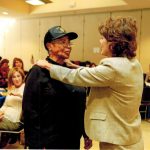
More than "Thank You" Veteran Ceremony
This 2-hour ceremony is designed for Veterans, their families, civilians, healthcare providers, and citizens to help Veterans lay their burdens down. Safe sanctuary is provided where losses are acknowledged, honored, mourned, and redeemed. These losses might include:
- Comrades who were wounded or died in battle
- Loss of personal physical/mental health
- Loss of the self they had prior to the trauma
- Assault that occurred within their own ranks
- Unfair government administrative action

Participants experience some level of healing even if they only witness the ceremony without participating in it. Family members are also encouraged to attend because they are secondarily impacted by their loved one’s trauma plus they are the ones providing needed support on a regular basis. They are the “unsung heroes” whose sacrifice goes unacknowledged. Civilians and Citizens are encouraged to attend so they can accept their responsibility to help heal our nation after war. Healthcare workers will learn how to provide a safe environment so that the wounds Veterans sustain in our name can be healed together.
Following the program, the host facility might provide mental health counselors, massage therapists, chaplains, bereavement support, and veteran resource programs. Exhibits provide resources for continued information, care, and support.
How Did Fallen Comrades Ceremonies Originate?
Opus Peace non-profit organization was providing consultation services at a state veterans’ home so staff would better understand how to care for the unique needs of veterans as they age. One veteran was asked, “Is there anything from the war that might still be troubling you now?” The veteran started crying, saying: “My brother and I both went to Vietnam, but I was the only one who came back.” Then, he added: “I didn’t even get to go to his funeral.” A memorial service was subsequently provided for him and for all the veterans at the facility who held similar losses. Unmourned loss and unforgiven guilt were finally liberated and the result was visibly evident! Now, YOU can provide “More than Thank You” ceremonies in your community.
Soul Restoration Ceremony for Personal and Professional Caregivers, Administrators, and Volunteers
Ongoing, unrelenting, caregiving can wear a person down. It slowly and gradually exerts PTSD-like effects on the brain and nervous system. Whether providing care to a family member or working as a professional healthcare provider, caregivers face loss, change, and transition on a daily basis. Because the losses are chronic, they may not even be recognized, subtly robbing the care provider of their own sense of self (a Soul Injury). This can produce notable physical and emotional symptoms, interfering with personal and professional well-being. The literature now recognizes this as “Secondary Traumatic Stress Disorder” (STSD). Unfortunately, it often goes unassessed. Yet, organizations with staff who work in burn-out rich environments (ICU, ER, Hospice, Foster Care, etc.) have a duty to assess, respond to, and prevent STSD. To fail to do so, is unethical.
Professional caregiving sometimes threaten to squeeze the soul out of the workplace. Personal caregiving might squeeze the soul out of the relationship. This occurs because both personal and professional caregivers often disconnect from the part of self that is carrying their pain. This disconnection unwittingly contributes to loss of energy, emptiness, and “compassion fatigue.” Re-connecting with the part of self generating the pain, paradoxically, restores wholeness.
The Opus Peace Soul Restoration program for caregivers has two parts. The information section provides education on:
- Secondary PTSD
- Current research relating to the brain and neuroplasticity
- Re-setting the brain by accessing the self-compassionate part of the brain
- Transforming the brain by installing new “software”
- Cultivating honesty, courage, and humility to do the work of “soul restoration”
The Soul Restoration ceremony, acknowledges the hardships that care providers have incurred, teaches them how to grieve and release the losses they face, and helps them learn how to become a “gracious receiver.”
How did the Soul Restoration Ceremony for Personal and Professional Caregivers originate?
Two merging forces compelled Deborah Grassman, the Founder of Opus Peace, to initiate Caregiver ceremonies:
- Most self-care programs focus primarily on improving physical and emotional health (diet, exercise, massage, breathing techniques, mindfulness, etc.), and “resiliency training” without addressing loss, guilt, and shame that healthcare providers experience as they daily witness patients’ and their families’ acute and/or chronic suffering.
- Increased documentation requirements, governmental regulations, and dwindling resources have caused supervisors and administrators to focus less on staff needs because time and resources are simply no longer available.
“As a Nurse Practitioner AND as a Hospice Director, I was on both sides of the fence,” says Deborah. She adds that when she started in Hospice 30 years ago, attention and resources were spent on the bereavement needs of staff. “Little by little, over the years, staff needs started taking a back seat to other pressures. I could no longer provide the 1:1 support they needed and Employee Assistance programs really didn’t know how to help staff grieve.”
Deborah’s frustration grew when she attended conferences that focused on self-care. “Too often, we were being told to ‘be more resilient’ or to ‘work smarter, not harder.” Deborah believes that these kind of platitudes only make staff feel guilty because it isn’t always possible to be smarter or more resilient. “I was caught in an ethical dilemma of not being able to respond to needs of the staff without compromising either patient care and/or needed administrative duties.”
Deborah did her Master’s degree thesis on the relationship between ceremony and hope. “This was an answer to the dilemma I was in. I learned how to construct effective ceremonies that are not only efficient, but effective with large groups of people. At last, I had a tool that was neither time-consuming, nor labor-intensive.”
